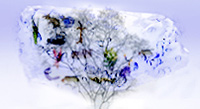2006/3/30
|
| Introduction to Resource Center No. 7 |
|
 |
 |
 |
 Overview of Resource Operations Focused on the Mutant Strains of Asagao Overview of Resource Operations Focused on the Mutant Strains of Asagao
Eiji Nitasaka: Graduate School of Science, Kyushu University (Resource Center)
Shigeru Iida and Atsushi Hoshino: National Institute for Basic Biology
(Sub Resource Center)
Michiyuki Ono: Graduate School of Life & Environmental Science, Univ. of Tsukuba
(Sub Resource Center)
Website: http://mg.biology.kyushu-u.ac.jp/
Contact e-mail: enitascb@mbox.nc.kyushu-u.ac.jp (Nitasaka)
|
Plant resources and information provided by the center
• Seeds from mutant and natural population strains of asagao and its related species
• Mutant gene, molecular markers, and linkage maps
• Images and references of asagao ( Edo period-Present)
• EST clones derived from bud-flower stages and embryo plants
(National Institute for Basic Biology)
• Seeds of transgenic strains (The University of Tsukuba)
• Short-day photoperiod-specific EST clones (The University of Tsukuba)
|
|
(1) History and Overview of Resources and Operations |
The Japanese morning glory (Ipomoea nil or Pharbitis nil) or Asagao (hereafter referred to as asagao) is not indigenous to Japan. In fact, it is considered to have been introduced from China as a hypercathartic medical herb around the 8th century. Since then, it has been cultivated for its flowers and has evolved into different variations due to transposons, becoming a unique garden plant in Japan (Fig. 1). Since the rediscovery of Mendelfs law, asagao has been used as a research material in genetics and numerous hybridization experiments has been conducted until the start of war. The results were reported in more than 200 journal articles, and a linkage map consisting of 10 of 15 linkage groups was generated. Most of these researches were conducted by Japanese geneticists, and asagao is the second most thoroughly genetically analyzed plant after maize. In addition, asagao is a typical short-day plant, and due to its sensitivity to day length, it has also been used as a research material in studies in the field of plant physiology to determine the anthogenesis (flower formation) mechanism.
In addition to having characteristics suitable for fundamental plant science researches, regarding areas in application, asagao is used in horticulture and as a model plant for a congeneric crop, the sweet potato. Therefore, the consolidation of asagao resources will gain importance. For this reason, our resource center collects, preserves, and provides mutant strains and EST clones.
Currently, more than 1,000 asagao strains are being preserved at Kyushu University which is the core facility. Approximately half of the strains (550 strains) were originally derived from the strains which Dr. Yo Takenaka of the National Institute of Genetics (NIG), had collected as research material unique to Japan for exhibition at the International Congress of Genetics held in Tokyo in 1956. In addition to asagao, various species such as radishes (Sakurajima Daikon and Moriguchi Daikon), wheat, rice, silkworm, chicken (long-tailed cock), and goldfish were also exhibited as research materials. Subsequently, after the retirement of the engineering officer, Mr. Jin-ichi Tamura in 1993, the seeds of the asagao strains preserved at the NIG were refrigerated without being regenerated. However, in 1997, these stocks were transferred to Kyushu University, and the regeneration, preservation, and research on the strains were reinitiated. Kyushu University was selected for the National BioResource Project (NBRP) which was launched in 2002 and since then has started to collect related wild-type species globally and resumed collecting strains from private asagao aficionados. Furthermore, transcription factors and transposons for a series of enzymes involved in the anthocyanin biosynthesis pathway responsible for the color of the asagao flower were analyzed in collaboration with two groups which functioned as the sub facilities, the National Institute for Basic Biology (NIBB) group who was working on the construction of EST clones and University of Tsukuba group who had constructed a transgenic asagao strain and was performing researches on the elucidation of the molecular biological mechanisms. In this manner, the largest asagao stock center in the world was established (Fig. 3). To date, only a few researchers use asagao or its related species as a research material, and most of the groups conduct their researches based on their interest in evolution and ecology.
I (Nitasaka) was formerly researching molecular genetics with Drosophila. However, since I was young, I was interested in cultivating various types of morning glories (morphogenic mutants) as a hobby and planned to conduct a research using them in the future. Therefore, when I learnt about the condition of the asagao strains preserved at the NIG, I volunteered myself for the preservation operations of the strains. Most of the mutant strains of asagao currently preserved at the stock center were derived from natural mutations which occurred in the late Edo period due to the displacement of transposons (described later). Many of them were sterile and could not produce seeds since they were homozygous, and for stock preservation, it was necessary to identify the mutant trait from the seminal leaf stage. Since I had long familiarized myself with the required techniques, it was not difficult for me to maintain the strains after the transfer of control and to understand the records in the strain register. In addition, I got hold of some of the strains that I had lost back when I was cultivating them as a hobby and there were some strains that I am deeply concerned with. |
|
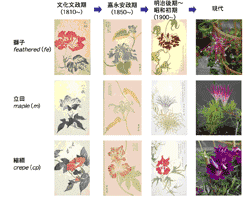
Fig. 1: Genealogy of the Mutant Strains of Asagao. In the process of obtaining strains of high value,
various mutant strains were produced and are preserved to this day. For example, a single mutant in the feathered gene exhibits
relatively simple morphology. However, strains with modulating mutations that strengthen the mutation were selected and it was
clear that they exhibit a peculiar morphology, similar to the present strains.
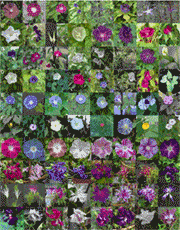
Fig. 2: Examples of Asagao Strains Preserved at Kyushu University.
A. Seminal leaf. Strains that naturally exhibit mutant traits in leaves and flowers (pleiotropy)
B. Mutants related to floral morphology
C. Mutant traits related to the shoots
D. Mutants related to the shape and color of leaves
E. Natural population strains and species closely related to asagao
F. Plants belonging to the genus Ipomoea
G. Large-flowered asagao. Multiple variants with enlarged flowers. Which genes could possibly be responsible for generating a flower of 20-cm diameter?
H. Multiple variants related to morphological mutations (varied asagao mutants, feathered strain)
I. Saizaki strain
J. windmill double flower (Kurumazakibotan) strain.

Fig. 3: Image showing open cultivation in Kyushu University. In summer, the plants are grown on a large scale and lots of seeds are collected to record the strains and to renew the seeds. In addition, wild strains that do not show any distinct mutant traits are occasionally cultivated in a glasshouse in order to avoid cross hybridization.
|
|
(2) Features of the Preserved and Provided Resources |
y`zPlants that are Easy to Observe and Hybridize and have a Relatively Short Generation Time
Many plant researchers may have a preconceived notion that the continuous cultivation of asagao is difficult due to its relatively large plant body and seemingly lengthy generation time. However, in reality, subjecting them to short-day treatments such as the short-day condition in winter or storing them in a dark room once or twice will easily trigger flower bud differentiation. In addition, the plants will blossom in a month after sowing and the plant body can grow in a small space. Therefore, mass cultivation in a limited space is possible (Fig. 4). Asagao also has large flowers and leaves, allowing any subtle variation to be easily observed even by the naked eye, and emasculation and hybridization can be performed easily. Moreover, it has a mechanism that enables them to automatically pollinate right before blooming which results in an extremely high self-propagation rate. It is very easy to visualize recessive mutants or to maintain sterile strains as heterozygotes during self-pollination in hybridization experiments, strain preservation, or mutagenesis experiments. Asagao is a plant with numerous mutant variations related to flower colors and designs. The mutants of most of the enzymes and transcription factors involved in anthocyanin biosynthesis exist and the genes responsible for the mutations are elucidated. Furthermore, although not widely known, morphological mutants are varied, and strains with various combinations of mutations were constructed and are available for analyzing the interaction of each mutation.
yBzHomogeneous Genome
One of the remarkable properties of asagao is its homogeneous genome. Currently, the Japanese Tokyo Kokei Standard (TKS) and Murasaki (Violet) are widely used in genetics and physiology respectively as standard wild-type strains. Similar to these strains,
there is no base substitution in the introns or intergenic regions for the asagao strains if the inserted regions of the transposons are disregarded. Possible explanations could be that asagao is derived from a small number of seeds that were introduced from China, or that a strain
which emerged in the late Edo period due to the displacement of activated transposons was favored for its phenotype and was cultivated, and it became widespread. It is well known about plants that single mutant strains cannot exhibit a distinct phenotype because multiple genes with
identical functions will cause redundancy. However, asagao exhibited an extremely distinct phenotype in most cases when their mutants were compared with other plants which possess orthologous mutations .Fig. 5 shows an example of genetic mutation in
floral organogenesis where asagao exhibits an extremely distinct phenotype even when complete organ transformation is usually not observed in other model plants. Although there is a possibility that the analyzed gene was simply not redundant, another possibility is that in the case
of hybrid plants, genes interacting with each other are not completely correlated and thus appear redundant.
In addition, detecting minute changes in the amount of transcription in genetic interactions analysis will be important in the future and under such circumstances, asagao would be considered to be a good experimental model because background noises can be reduced
due to its homogenous genome. Clearly, mapping by molecular markers will be impossible unless some degree of base substitutions (polymorphism) is present. Nevertheless, contrary to asagao which has a homogeneous genome, natural population strains which exhibit sufficient polymorphism
can be found worldwide. They are conspecific to asagao and thus show a high hybridization success rate and are useful for mapping. Furthermore, since other related species such as the Ivy-leaved morning glory (Ipomoea hederacea) can now be used for hybridization, asagao is expected
to be utilized as a model for combined studies on molecular and morphological evolution such as (molecular) genetic analysis of stable traits in evolution.
ybzEndogenous Transposons with High Displacement Activity
Although there are numerous mutants related to the existing flower colors or morphologies, researchers should consider other perspectives during mutant screening. Asagao has
highly active endogenous transposons (belonging to the Tpn1 family) and studies show that even
when compared to strains used in experiments involving induction of mutations by chemical mutagens, the progeny of these highly metastatic strains generate mutants at a greater frequency. Once an insertion mutant is obtained, it is possible to identify copies with Tpn transposons
that were inserted in different regions by comparing the mutant with a revertant to wild type using the Simplified Transposon Display (STD) method. In other words, the Tpn lost in the revertant will be the one that was inserted in the causative gene of the mutant traits, and the
causative gene in the mutant can be isolated by referencing the sequence of Tpn. Furthermore, the Tpn1 family in asagao which belongs to the En/Spm superfamily is primarily transposable, and strains for a related species, I. purpurea which has a transposable Tip100 element that
belongs to the Ac/Ds superfamily and a recently discovered transposable element, Helitron exist (Fig. 6). In this manner, these strains are promising for the elucidation of the displacement mechanism of transposons by genetic and molecular biological methods.
There are other various characteristics. In my opinion, the fact that the flower is beautiful makes asagao superior to other model plants.
|
|
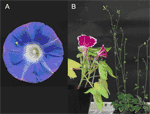
Fig. 4: Comparing the size of Asagao and Arabidopsis
A) The Asagao flower and the Arabidopsis flower
Asagao is a standard-sized (-6 cm) Iranean strain. Can you locate the Arabidopsis flower? The conventional morning
glory that was introduced to Japan is considered to be similar to Arabidopsis, although the aging and color degradation
observed in the flowers of the strains derived from a natural group is more rapid than those of the asagao strains.
Furthermore, color degradation in this flower started from the periphery.
B) Asagao and Arabidopsis which blossomed under short?day condition (Col-0).
The Arabidopsis blossomed at the same time as asagao even though it was seeded first. Asagao won!
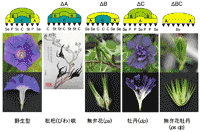
Fig. 5: Mutants Related to Floral Organs. Mutant genes corresponding to each mutant gene in the well-known ABC model of floral organogenesis are also observed in asagao.
The Biwazaki which is believed to be an A functional gene deficient mutant was recorded in gAsagao kaiho (Morning glory newsletter)h but is currently extinct.
Last year, a novel ps mutant was found during the cultivation process, and its gene corresponds to the PI gene in Arabidopsis. This diagram shows 10 calyces transformed from the original
calyces and petals; 5 of the small-sized pistils, and 1 of the original pistil located in the center. In the double mutant strain with double flower mutations, flowers that consist of only calyces bloomed. Since all these flowers are sterile, strains containing heterozygotes with mutations (a host parent) are used for their preservation.
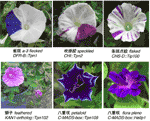
Fig. 6: Insertion Mutants Derived from Transposons. The top and bottom photos on the far right are mutants of the Ipomoea purpurea, a species related to asagao. Strains that exhibit such unstable traits are difficult to maintain since their phenotype switches back easily to that of wild-type strains; therefore, it is considered that they may become extinct unless preserved by a public organization.
|
|
|
(3) Future Perspectives |
Since a long time ago, researchers have collected asagao from private collectors and
have used them for research. Unfortunately, almost none of the strains that had been used for genetic analysis before the war survived.
Thus, coordinate indexing are conducted with allelism test of mutations and analysis of genetic information based on the strains recollected
from private collectors after the war. Therefore, it is necessary for the resource center to consolidate a system in order to permanently
preserve the strains. In addition, although we have collected a considerable number of strains preserved by private collectors, the collection
operations should be hurried since the collectors are aging; this is a significant factor in the NBRP operation.
With regard to the genome analysis of asagao, approximately 50,000 EST clones have been collected and preserved in this project thus far, and the sequences of these clones have been published in public databases. It is expected that the consolidation of the BAC clones will be initiated. Moreover, although a linkage map was constructed based on a hybrid strain of asagao and the Ivy-leaved morning glory, it is not suitable for the mapping of novel mutants because the hybridization success rate of asagao and
the Ivy-leaved morning glory is low (below 5%). Therefore, we have selected hybrid parents of natural population strains from identical species which possess many polymorphisms and show a high success rate for hybridization and have started preparations to construct a new linkage map.
Although asagao can be cultivated under short-day conditions in a relatively small space, the small-sized asagao plant is the best to facilitate cultivation in a climate chamber or mutant screening through massive cultivation in an outdoor farm field. Moreover, since asagao is a vine plant and intertwines around adjacent vines, it would take a huge effort to prevent seed contamination in mass
cultivation. Recently, after being inspired by Microtom (small tomatoes), a model of solanaceous plants which has been receiving attention, we constructed multiple variants of the dwarf mutant (dw) and small tiny strain and are trying to construct small standard strains with the highest fertility possible.
Currently, the community of morning glory conducts a biennial research meeting with each research group taking turns as the host. Approximately 100 researchers attend these meetings to present their research accomplishments to each other. Recently, the third meeting was held in Niigata University in May 2005. We sincerely hope that the number of researchers involved in researches related to asagao will increase in the future, and for this purpose, we would like to continue our efforts on the consolidation of the research environment for asagao. We appreciate your cooperation and will be grateful for your support. |
|
|
|
 |
 |
 |
 - Application of Google Earth - - Application of Google Earth -
|

|
A virtual globe software known as "Google Earth" which was introduced in this section last year is now being tested for a specific application.
On March 29th, Honda Motor released data for a car navigation system that can be viewed using Google Earth as a demonstration.
As such information continues to increase, within a few years, it might be possible to make use of IC tags or GPS and have the data updated in real-time. It is exciting to imagine that a car navigation system of such great value can be realized.
This system displays the road conditions in three colors --blue (smooth), orange (crowded), and red (jammed) The information is not delivered in real-time but is renewed in the morning, midday, and evening.
(URL: http://internet.watch.impress.co.jp/cda/news/2006/03/29/11429.htm) |
Figure: Roads in the Vicinity of Imperial Palace and Tokyo Station are Jammed.
|
|
|
|
|
| Information Technology Vol. 12 |
|
 |
 |
 |
 "Bioinformatics in 10 minutes" "Bioinformatics in 10 minutes"
"Let's Use a Terminal Window (Mac OS X)"
Please do not worry even if you have not heard of the term, "terminal window." This section is targeted for those who are not
familiar with it. On the other hand, this article might be too easy for those who know what a "terminal window" is.
Letfs start using a terminal window.
1. Double click on Macintosh HD, followed by Application, and then Terminal in that order to launch the terminal window. A screen similar to one shown below should pop up (The testuser is the user name and it will be different on your computer. Hereafter, please replace testuser with your own user name).
 |
2. Type pwd on the terminal window and hit Enter. The pwd command displays your current directory.

This indicates that you are in the /Users/tetuser directory.
Those who cannot picture this situation are advised to double click on Macintosh HD and click on the home icon (Fig. home) (Hereafter, it is referred to as the "User folder"). You can then see the folders on your Desktop, Documents, Library, Movies, Music, and Pictures.
Next, type ls and hit Enter.

The folders contained in the User folder such as Desktop, Documents, Library, Movies, Music, and Pictures are listed in English.
Do you have a better idea of where your location is now? |

Fig.Fhome |
3. Place a file named dna.txt that contains the following base sequence (which does not have to be accurate) in the User folder.
aaaaaaaaaattttttttttggggggggggcccccccccc
Type ls on the terminal window and hit Enter. The dna.txt will then be listed additionally to Desktop, Documents, Library, Movies, Music, and Pictures. |
4. If we just stop here, this wouldn't be a bioinformatics article, would it? Lastly, let us excise the bases from position 11 to 30 of the abovementioned base sequence.
Type the following on the terminal window and hit Enter,
perl -lne eprint substr($_, 10, 20)f dna.txt

A program called perl was used for this excision. Plenty of information can be found regarding Perl on the Internet and in books; therefore, we suggest you to try a lot more besides excision. |
|
(Shingo Sakaniwa)
|
|
|
Editor's Note: Dr. Nitasaka liked asagao very much ever since he was a kindergartner.
It seems that he tried to order seeds that had been distributed by the National Institute of Genetics at that time but
was refused. After several decades, when there was no asagao researcher left at the National Institute of Genetics, he
took charge of all the seeds and established the current resource center. He is a front?line researcher and a "superman"
who is capable of managing issues from resource administration to database construction. The number of people using the
database of asagao is much more than those using the databases of other species.(Y.Y.) |
Contact: Yata 1111, Mishima, Shizuoka 411-8540, Japan
Center for Genetic Resources Information, National Institute of Genetics
Tel: 055-981-6885 (Yamazaki)
E-mail BRnews@chanko.lab.nig.ac.jp (translated by ASL translation service and proofread by Sharoh Yip) |
|
|
